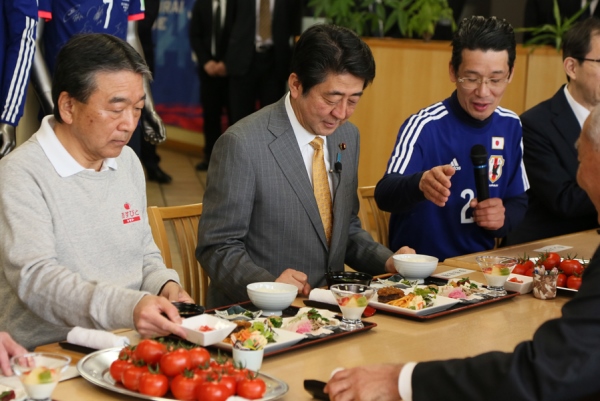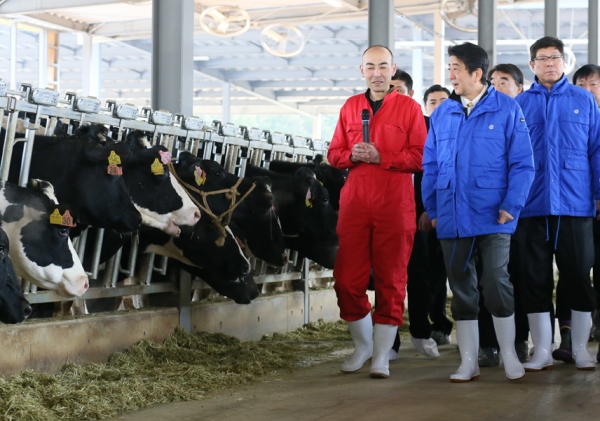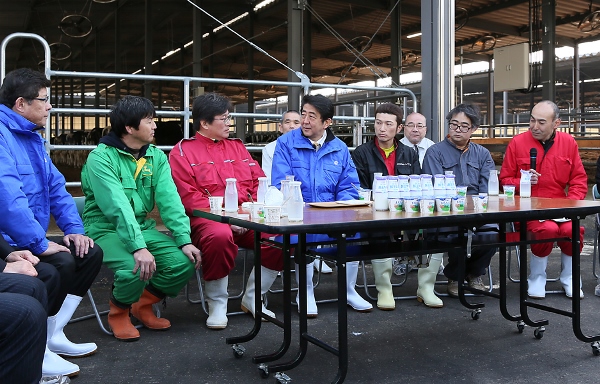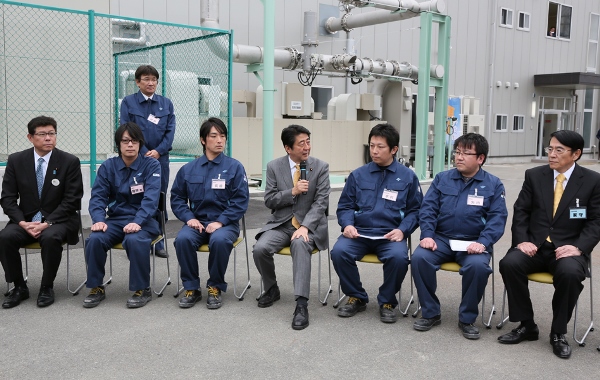Home > News > The Prime Minister in Action > March 2016 > The Prime Minister Visits Fukushima Prefecture
The Prime Minister in Action
The Prime Minister Visits Fukushima Prefecture
March 5, 2016
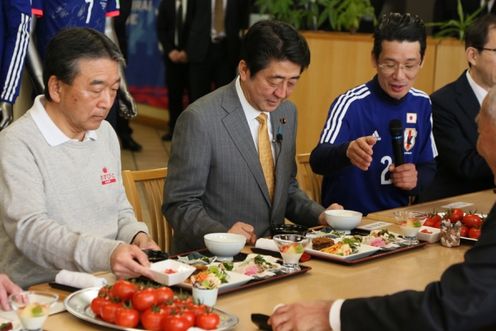
Photograph of the Prime Minister meeting with chefs at a restaurant
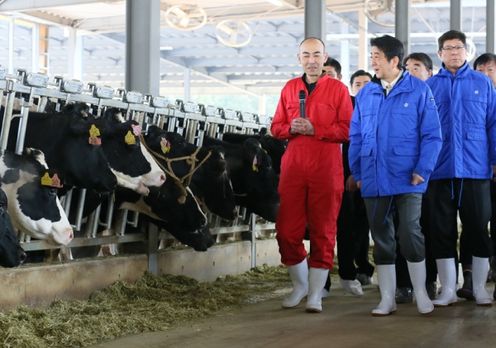
Photograph of the Prime Minister visiting a reconstruction farm
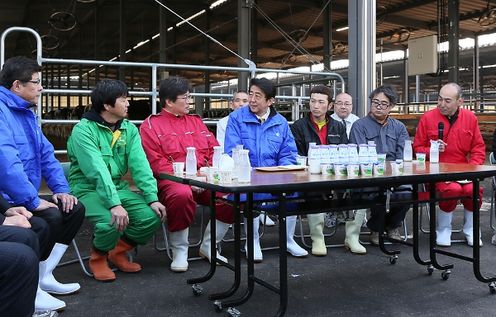
Photograph of the Prime Minister meeting with dairy farmers
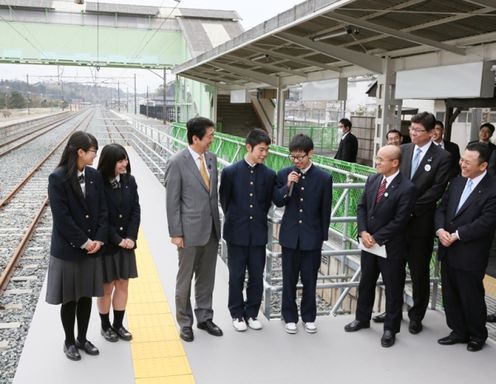
Photograph of the Prime Minister visiting JR Odaka Station
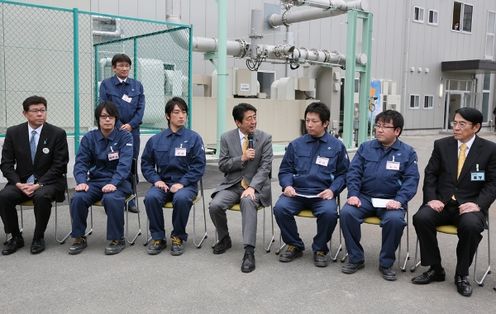
Photograph of the Prime Minister meeting with factory workers and others
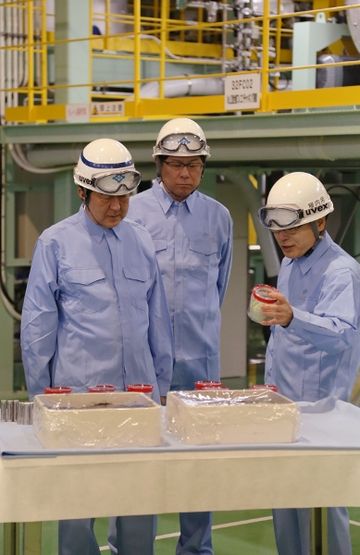
Photograph of the Prime Minister visiting a factory
[Provisional Translation]
Prime Minister Shinzo Abe visited Fukushima Prefecture.
The Prime Minister visited a reconstruction farm in Fukushima City, JR Odaka Station in Minamisoma City, and a restaurant that opened after the Great East Japan Earthquake in Hirono Town. Afterwards, Prime Minister Abe visited a factory in Naraha Town that recently began operations manufacturing parts for electric vehicles.
After his visit, the Prime Minister said,
“Next week will mark the fifth anniversary since the Great East Japan Earthquake. Today, I visited Fukushima Prefecture. I also visited Fukushima Prefecture three days after beginning my second term as Prime Minister.
There can be no revitalization of the Tohoku region without the revitalization of Fukushima. Moreover, there can be no revitalization of Japan without the revitalization of the Tohoku region. This is the basic stance of the Abe administration. The reconstruction of Fukushima and the Tohoku region is a top priority.
Earlier today, I visited a farm. I was able to talk with the people there who have started that new farm, and taste their milk and yogurt. The taste was excellent. I was able to feel the famers’ passion and desire to share the wonderful food of Fukushima to ever more people across Japan. I felt that it is precisely the passion of people like these farmers that will be the driving force for reconstruction.
I have instructed the Minister of Land, Infrastructure, Transport and Tourism to work quickly to compile detailed proposals to create four lanes at problem areas of the Joban Expressway in order to alleviate traffic jams. I heard from high school students in Odaka about their hope that all lanes of the Joban Expressway will be fully opened.
I think that many local people are waiting for the reopening of this road. I have instructed the Minister of Land, Infrastructure, Transport and Tourism to promptly announce the time period for the full opening of the Expressway.
Just yesterday I received a proposal from the ruling parties on how to address zones where the return of residents would be difficult. The Government will consider the issue based on that proposal.
We must quickly remove decontamination waste from areas where people live and start placing it into interim storage facilities. Next week, I will call upon the relevant ministers to report the state of progress. I intend to further bolster our efforts.
I visited a factory in Naraha Town producing new lithium batteries, and saw people who have returned to the area working there with high motivation and hopes. I could see firsthand how the seeds for the energy society of the future are blooming in Fukushima.
We will create enough hydrogen through renewable energy projects in Fukushima to power the equivalent of over 10,000 fuel cell vehicles by 2020. This power will not just be used within Fukushima Prefecture, but also for the Tokyo Olympic and Paralympic Games.
I intend to turn Fukushima into a major production center that will provide hydrogen energy throughout Japan, one that will lead us to a future hydrogen-based society. We could call this the “Fukushima concept for a new energy society.” We will create a council for realizing this concept comprising members from the public and private sectors. I have told the Minister of Economy, Trade and Industry that I want to begin concrete discussions in this council sometime this month.
I intend to continue to work hard towards achieving reconstruction as soon as possible. We will accelerate reconstruction so that the people of this region, who even now are forced to continue to endure various hardships, can return to the way their lives were before as soon as possible.”
Additionally, in response to a question on economic policy, the Prime Minister said,
“We will hold the Summit in Ise-Shima this year. I hope that the leaders of the G7 will analyze the current state of the global economy together, discuss what kinds of collaboration can be carried out, and send out a clear message about that.
I also hope to continue to contribute to the sustainable and robust growth of the global economy.
Formulating the budget for fiscal 2016 at an early date will be the most powerful means of providing economic stimulus. Budget deliberations are still currently underway. I intend to work with a sense of urgency and establish the budget as soon as possible.
I am not thinking about a supplementary budget at all at this moment in time.”

